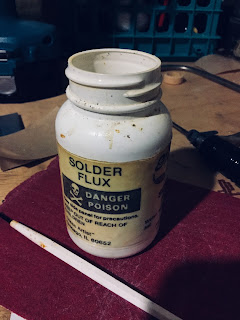Fabricating Typewriter Keys
A Fox #5 from 1905, purchased from a key-chopper by D. Seaver
One of the major downfalls of the typewriter was not the rise of the personal computer, but the recent interest in the "steampunk movement." I have nothing against this style, or the people who create unique pieces in it. What I don't like, and what many people don't like, are the people who cut the keys off of old typewriters. They target the oldest and rarest of machines and strip away the interface between the fingers and the page, leaving the rest to rot in a waste bin. Rather then restoring them and letting them survive to educate another generation, to be allowed to continue their purpose which they were so carefully crafted to do, they are crudely dismantled and ruined. Above is a picture of an early 1900 upstrike typewriter. Rare enough on its own, machines like these are usually the victims, with their charming glass keytops. It is in fully restoreable condition, however the distinct lack of keys turns many people away.
I just don't see the value in destroying a historical device that will never be made again, only to glue a pre-made object onto another pre-made object, only to throw the rest away. Sure these keys make nice cuff-links, or earrings, or bracelets, but I'm certain there is another way, which is why I began experimenting with different methods of keytop fabrication.
The most difficult problem to solve, are the nickel and chrome key rings. These are small rings with tabs on the bottom that hold the glass and the paper to the key. Specific tools, hard to find today, were manufactured with the purpose of removing and replacing these pieces with ease, but without them, it's quite the feat. I have not found a way to replicate this process completely, but I've thought up of a way to make something with a striking similarity. It is a labor intensive process, but if it produces the right results, than machines like the Fox above can be repaired. I am glad to say, however, that the Fox has fallen into the hands of a preservationist several years ago.
I began this process by making a quick printout of some half inch key legends. Good quality reproductions are available online, but this was a basic experimental process. I traced the half inch circle on both a sheet of aluminum, and a piece of standard thickness glass (1/16"), and cut one of each out.
The glass was then ground to a circular shape, and the legend was cut out. I stacked the disks appropriately and wrapped the whole thing in copper foil tape as neatly as I could, and realized two things. First, the solder might not look like a keycap. Second, the whole thing is slightly too small. The keyring adds a bit to the diameter of the key. But I continued anyway, with my imperfect circle, and my questionable foil job. It's just a proof of concept anyways.
The last thing to do is add the solder. Some people may recognize this as standard Tiffany Stained Glass procedures, and that it is. I've been doing stained glass for several years, and have taught one or two classes at a local art gallery. If this doesn't produce convincing results in a handful of attempts, I might try and solder a small ring on the top to give it more dimension (think Royal keytops).
Don't forget to use flux
Okay. So perhaps it's not that nice. That's alright, I know what I need to improve now. I tried cutting a larger key, and I'll work on that one later. Seems like I need to prune the foil a little better as well, so the face of the key is a true circle. Lots of work...
I've already ground down the glass for my second attempt, and made it as best of a circle as my eyes could tell. I also have another matching aluminum circle, and I'll use an unbleached paper legend. Maybe this one will be more circular and pleasant to look at? If you all out there have any better ideas on how to fabricate the ring, let me know. I had considered soft metal 1/2" piping with the edge curled in (metal grommets?). I think that would deliver the best results, but I'm unsure how to go about forming them. The pipe would have to be cut into rings, and the top end will need to be rolled inward. I might even attempt casting it. We'll see.
Just wanna preserve these as much as possible.
Back again, this is an edit with an update:
Tried once more on my keys, and have created something way better than my pancake glass thing last time. This time, I used a paperclip that I bent into a ring, and a larger diameter glass, with a better looking legend.
Cut, sized, and soldered the ring...
Foiled. And it looks way better than the last one did at this stage...
Now onto soldering....




















I think it looks great! I too dabble in stained glass, nad my first thought was perhaps to make these with those techniques. I have a small circle cutter too, so that might make these easier to make. Now to find good key reproductions. Any advice on those?
ReplyDeleteYou have a gift for breaking down complex ideas so clearly. Keep the brilliance coming. rekey locks
ReplyDelete